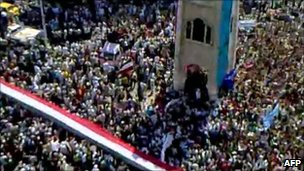Syria Snapshot: The Checkpoints of Defiance in Hama (The Economist)
 Hama Anti-Regime Protest, 1 July 2011A correspondent for The Economist gets into Hama, Syria's fourth-largest city, where protesters have maintained a large and loud presence despite military pressure.
Hama Anti-Regime Protest, 1 July 2011A correspondent for The Economist gets into Hama, Syria's fourth-largest city, where protesters have maintained a large and loud presence despite military pressure.
This despatch was written before last night's raids by security forces.
The city of Hama is both defiant and fearful. Boys with wooden sticks man makeshift checkpoints. Burned-out government cars, rubbish bins, gates, piles of bricks to street-lamps unscrewed at the base and carefully laid across the road have been used to create blockades to prevent the security forces from re-entering the city. Even satellite dishes, with the name of Al-Dounia, a pro-regime channel, scribbled over with Al-Jazeera, have been used. The streets are eerily quiet; shop shutters are locked and the roads are almost empty of cars. No sign of the Assad regime remains. Pictures of the president, Bashar Assad, have been torn down and a plinth where a statue of his father, Hafez, once towers stands empty. Outside the city, the government's forces wait.
A week ago the government tried re-take the city. In response, residents say, neighbourhoods organised overnight. At least 24 people have been killed in Hama and 500 arrested since the unrest began, but security forces have not been able to enter the main areas of the city of 800,000. The city, the fourth largest in Syria, has been galvanized by its size and by its history. Everyone knows each other and word travels quickly. Everyone has a relative who died in 1982 when Hafez Assad, the former president, killed tens of thousands in an effort to quash an Islamist uprising. Everyone knows someone who lost a son, husband or father on June 3rd, a date now similarly etched on the city's memory, when over 70 people were shot dead. They have been able to organise quickly and effectively.
During the day, the checkpoints are manned by five or six sleepy men or children, perched on concrete steps or lolling on mats in the sweltering heat of the day. At night at least 15 men keep a careful watch. Rich locals bring them food and water. The barriers would be no obstacle to a serious military assault but the government has hesitated so far. Cries of "Allahu Akbar" rang out when security forces approached on Thursday night, almost drowning out the gunfire. The security forces backed off but two men were killed.
Most predicted bloodshed on Friday after almost four weeks of defiance. Tanks and security forces assembled outside the city. Mohamed Mofleh, the head of military security who had been removed at residents' request after the violence of early June, had been reinstated. But a visit by Robert Ford, the American ambassador, gave those demonstrating heart.
On Friday, checkpoints were removed to encourage protesters to enter the city centre. The call to prayer rang out and the city burst into life. On every street, people marched waving olive branches and pink roses. They poured into Aasi Square, where a banner fluttered, emblazoned with the words, "Long live free Syria! Down with Bashar al-Assd!" Two vans parked in the middle of the square functioned as a makeshift podium from which men led the cries: "The people want to topple the regime!"; "No to dialogue! No to Bashar!" The crowd of thousands repeated the chants back. A Syrian flag, three kilometres long, was paraded up and down the road. Another van drove around distributing free water to thirsty protesters. Men hung off the balconies and rooftops of surrounding buildings, some filming with mobile phones. Fewer women ventured out this week; some were too scared, others had been sent out of the city with their children. But a small group in black abeyas shouted and waved olive branches from the corner of the square.
In the evening the checkpoints reappeared. Drivers had to show their identity cards. But unlike government checkpoints, the boys in charge apologised for having to carry out the checks. At one they offered sweets and a squirt of perfume when they waved people through.
No-one was killed in Hama on Friday but 14 people died elsewhere in Syria. The city remains tense as another week of defiance dawns.
 Bashar al-Assad,
Bashar al-Assad,  Hafez al-Assad,
Hafez al-Assad,  Syria,
Syria,  The Economist
The Economist 
Reader Comments